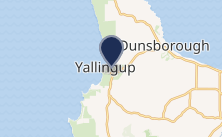Ngilgi Cave
Ngilgi Cave, previously known as Yallingup Cave, is a karst cave to the northeast of Yallingup, in the southwest of Western Australia.
| Ngilgi Cave | |
|---|---|
 Inside Ngilgi Cave | |

| |
| Location | Yallingup, Western Australia |
| Coordinates | 33°38′32″S 115°02′03″E |
| Depth | 39 m (128 ft)[1] |
| Length | 730 m (2,400 ft)[1] |
| Discovery | 10 October 1899[2] (European) |
| Geology | Karst cave |
| Access | Daily tours, closed 25 December |
| Registry | 6YA-1[1] |
In many sections of the cave a red layer of soil can be seen; this is called paleosol.
Discovery
The local Wardandi people have long known of the existence of the Ngilgi cave.[3] The Wardandi believe the caves to be their passage to the after life.[4]
Edward Dawson was the first European to enter the cave when he went searching for stray horses in 1899.[2] He acted as a guide to the cave from December 1900 to November 1937.
It was frequently promoted and was highlighted in early twentieth century tourism promotion materials.[5][6][7][8]
Naming
It was originally named for the nearby town of Yallingup but later renamed to acknowledge the cave's part in Australian Aboriginal mythology. Ngilgi (pronounced Neelgee)[9] was a good spirit who triumphed in battle against an evil spirit Wolgine.[2]
The story is part of the heritage of the Wardandi people who are the custodians of the caves in the area.[4]
Gallery
 Entrance to Ngilgi Cave
Entrance to Ngilgi Cave Plaque commemorating the discovery
Plaque commemorating the discovery "Two Tonne Stalactite"
"Two Tonne Stalactite" Rock formation
Rock formation
Notes
- "Australian Karst Index Database". Australian Speleological Federation. 2007. Retrieved 8 September 2018.
- Jochen Duckeck (2014). "Ngilgi Cave". Show Caves of the World. Retrieved 8 September 2018.
- Marisa Quinn-Haisu (18 November 2017). "Ngilgi Cave, Yallingup". Weekend Notes. Retrieved 11 March 2020.
- Hall, Susan (Summer 2007). Harding, Alison (ed.). "Wardan Aboriginal Centre" (PDF). Transwa In-service magazine. West Perth: Countrywide Publications. pp. 4–5. Archived from the original (PDF) on 29 August 2007. Retrieved 12 March 2020.
- The Caves of Western Australia. Perth: A.E. Forsaith. 1905. Retrieved 12 March 2020.
- The caves of Western Australia, A.E. Forsaith, 1910, retrieved 7 September 2018
- "BEAUTIFUL FOLDED SHAWLS IN THE YALINGUP CAVE, WESTERN AUSTRALIA". Sunday Times (Perth) (1287). Western Australia. 13 August 1922. p. 9. Retrieved 7 September 2018 – via National Library of Australia.
- "The WONDERLAND of the WEST". Sunday Times (Perth) (780). Western Australia. 15 December 1912. p. 3 (First Section). Retrieved 7 September 2018 – via National Library of Australia.
- "A dry day in wine country". The Sydney Morning Herald. Fairfax Media. 12 February 2005. Retrieved 8 September 2018.